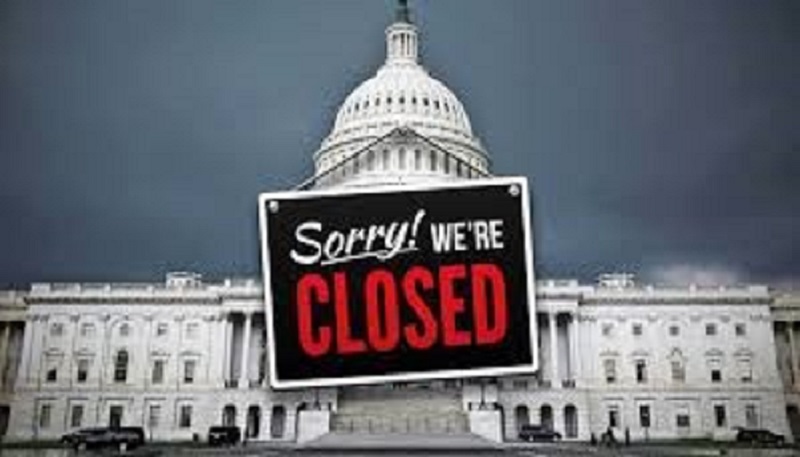- January 14, 2019
- Posted by: Prerna Chahar
- Category: Featured, GLOBAL GOVERNANCE & POLITICS, Latest Work

12th January, marked the most extended partial shutdown in United States history that beats the previous record of 1995 under Clinton’s administration. Trump’s demand of $ 5.7 billion for building a security wall on the Southern Mexico border by claiming “if we don’t have border security, we will shut down the government” has left about 800,000 workers without a paycheck and half of them furloughed. Moreover, President Trump threatens to declare a national emergency to bypass Congress if House Democrats do not concede to his demand to secure the $5.7 billion funding. Before visiting the Southern U.S. border on 10th Jan, he remarked: “We’re either going to have a win, make a compromise because I think a compromise is a win for everybody or I will declare a national emergency”. Amidst the U.S longest lapse in federal funding, the foremost question that arises; is there any solution or the middle ground to end the current shutdown?
Shutdown Economic Costs & Impact
The economic impact of U.S. shutdown is likely to be felt across its labour market and capital economy. Mark Kiesel, Chief Investment Officer of global credit at Pacific Investment Management Company raised concern by stating, “It’s only a matter of time before we start to see this in the real economy”. In 1982, a Congressional Subcommittee on Civil Service of the Committee on Post Office and Civil Service, House of Representatives estimated that the two-day shutdown cost taxpayers between $80 million and $90 million. According to government estimates, the U.S. government shutdowns that included furloughs in 1984, 1986 and 1990 cost taxpayers at least $128 million. About the current shutdown, S&P Global Ratings have suggested that if two more weeks the shutdown continues then it will cost the economy more than $6 billion which will exceed the price of Trump’s much-touted border wall. Beth Ann Bovino, S&P’s chief, U.S. economist, noted “We estimated that this shutdown could shave approximately $1.2 billion off real GDP in the quarter for each week that part of the government is closed. That may seem like pennies for the world’s biggest economy, but it means a lot to those workers trying to cover their household costs without their paychecks”. Hence, the longer the shutdown, the worse is the long term impact.
Shutdown Impasse: Trump vs Democrats
The nature of politics in the U.S. is undergoing a transformation, the underlined polarization and partisanship that has developed under Trump administration has created a divided America, generated politics of fear and deepened the social wedge in the American society. Democrats and Trump disagreements and diametrically opposite view on the issue has continued the most extended shutdown in U.S. history. While one is longstanding the fight in the name of border security, the other side wants to reopen the government.
President Trump by calling for the partial government shutdown and extending threats to declare national emergency has once again shown his militant face. He knows that options are minimal therefore the call for declaring an emergency is just a way of pressurizing the other side to give in to his demand. He is determined to maintain the course to please his supporters and is hardly concerned about the common man suffering or the economic and social consequences the shutdown is likely to result.
For Democrats, on the other hand, approval of $5.7 billion funding for border wall is an ineffective and outdated solution to the complex problem. For them, it’s mostly a non-issue, unlike Republicans who call it a national security issue for which Trump is also willing to call for emergency. Democratic-led House voted to reopen the government, but Senate Majority Leader Mitch McConnell refused to bring the legislation up for the vote. The spokesperson for McConnell said “Republicans and Democrats will have to agree, not just one party,”
Deadlock in Sight?
The US government shutdown entered its 23rd day on Sunday and is likely to continue as the shutdown is not yielding the desired result that President Trump aspires. Both the sides, the Republicans and the Democrats have refused to come on the same page leading to the longest shutdown in the US history. The shutdown meeting of President Trump with Schumer and Pelosi hardly resulted in any discussion or negotiation. President Trump tweeted by saying that the meeting “was a total waste of time”, therefore leaving both the parties in the position from exactly where they started.
“Just left a meeting with Chuck and Nancy, a total waste of time. I asked what is going to happen in 30 days if I quickly open things up, are you going to approve Border Security which includes a Wall or Steel Barrier? Nancy said, NO. I said bye-bye, nothing else works!”
The face-off is likely to persist, and if the compromise is not reached soon, it would not only be dangerous for the U.S. economy but President Trump himself. Trump already does not enjoy popular support, and if the shutdown continues for another week, he is likely to lose his political support base.

